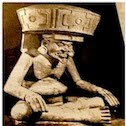In a previous post, November 2, 2012, I had realized, after several years of usage, that my astronomy book for telescopes, had illustrated our galaxy. The thing that struck me first was that the Earth we live on, was not shown. Yet, it was located around our sun in a very small section of one open spiral [See below, where arrows located our Sun; in one galactic view photographed from above and the other as a side view]. [1]
Our Galactic Solar Location
 |
| The Upper register is our Summer view of the Via Lacta while the Lower register is our Winter view. |
In an early presentation this month, at the University of Houston for the Southern Conference of Central Mesoamerica, I had also included two versions of the Earth: Winter view of the stars and the Summer view of the stars (north being straight up and the two versions of earth at 23.5° angles).
So that when we see our Summer Register [shown on the right side] Peru and southern countries below the Equator see the Winter register. The sky then appears to contain two different branches of the Milky Way. As it can be noted in the above view, the exact center actually shows that both the Upper and Lower Registers are shown in the same area of our particular spiral view; i.e the Spring and Autumn times of the year.
However, I remembere d that Seven Macaw and Tlaltecuhtli have similar stories. Both have the color blue, and also have lost parts of their bodies: Seven Macaw, lost both his teeth and metallic eye ornaments that were replaced by white maize kernels, whileTlaltecuhtli lost her arms and legs to two different comets. All were then carried down to earth.
Remembering the information given my by my dentists; that all constellations are upside-down south of the equator, an stramge thought struck me suddenly. What if . . . there is only ONE Milky Way branch that we see, that there is only one leg: our own particular single spiral of the galaxy?
However, having previously discovered that some constellations have only a 90° turn, while others have a 180° turnabout, both under AND over the equator, can it remotely possible that the view of all the stars changed into different formations, creating different configuraions, therefore becoming newer southern constellations?
I think that if astronomers created a huge cube as they have for the space shuttles to follow, and did a 3-D turn-around, one might just be able to distinguish the old as the cube is turning, just long enough to identify the new southern view. Are any astronomers able to do this project? I would like to know and maybe other people would like to know if this is possible or not?
NASA has all the star locations or else they would never have been able to send a telescope or other exploration shuttles out into the sky across empty voids free of such dangers as meteorites or asteroids. They also proved that they knew an asteroid had a specific orbit and were able to connect an exploratory shuttle [Tempe] to that asteroid.
Can they create such a sky cube as a 3-D image and rotate it so that new star compositions can be evaluated? I am quite sure they can.
______________
[1] Dickinson, Terence (1999, 20) Nightwatch: A Practical Guide to Viewing the Universe. 3rd edition.
[2] Ibid, (2001, 21)
 |
| The Earth in Orbit, 180° during the Fall and Winter And 180° during the Spring and Summer months.. |
However, I remembere d that Seven Macaw and Tlaltecuhtli have similar stories. Both have the color blue, and also have lost parts of their bodies: Seven Macaw, lost both his teeth and metallic eye ornaments that were replaced by white maize kernels, whileTlaltecuhtli lost her arms and legs to two different comets. All were then carried down to earth.
Remembering the information given my by my dentists; that all constellations are upside-down south of the equator, an stramge thought struck me suddenly. What if . . . there is only ONE Milky Way branch that we see, that there is only one leg: our own particular single spiral of the galaxy?
However, having previously discovered that some constellations have only a 90° turn, while others have a 180° turnabout, both under AND over the equator, can it remotely possible that the view of all the stars changed into different formations, creating different configuraions, therefore becoming newer southern constellations?
I think that if astronomers created a huge cube as they have for the space shuttles to follow, and did a 3-D turn-around, one might just be able to distinguish the old as the cube is turning, just long enough to identify the new southern view. Are any astronomers able to do this project? I would like to know and maybe other people would like to know if this is possible or not?
NASA has all the star locations or else they would never have been able to send a telescope or other exploration shuttles out into the sky across empty voids free of such dangers as meteorites or asteroids. They also proved that they knew an asteroid had a specific orbit and were able to connect an exploratory shuttle [Tempe] to that asteroid.
Can they create such a sky cube as a 3-D image and rotate it so that new star compositions can be evaluated? I am quite sure they can.
______________
[1] Dickinson, Terence (1999, 20) Nightwatch: A Practical Guide to Viewing the Universe. 3rd edition.
[2] Ibid, (2001, 21)































